transmission TOYOTA CAMRY 2014 XV50 / 9.G Owners Manual
[x] Cancel search | Manufacturer: TOYOTA, Model Year: 2014, Model line: CAMRY, Model: TOYOTA CAMRY 2014 XV50 / 9.GPages: 620, PDF Size: 7.47 MB
Page 2 of 620

TABLE OF CONTENTSIndex
2
1-1. Key informationKeys ..................................... 30
1-2. Opening, closing and locking the doors and
trunk
Smart key system................. 34
Wireless remote control ....... 49
Doors.................................... 55
Trunk .................................... 61
1-3. Adjustable components (seats, mirrors,
steering wheel)
Front seats ........................... 65
Rear seats ............................ 68
Head restraints ..................... 70
Seat belts ............................. 72
Steering wheel ..................... 79
Anti-glare inside rear view mirror.......................... 80
Outside rear view mirrors ..... 82
1-4. Opening and closing the windows and moon roof
Power windows .................... 84
Moon roof ............................. 87
1-5. Refueling Opening the fuel tank cap .... 91 1-6. Theft deterrent system
Engine immobilizer system ................................ 96
Alarm .................................... 99
1-7. Safety information Correct driving posture ....... 102
SRS airbags ....................... 104
Front passenger occupant classification system ......... 116
Child restraint systems ....... 122
Installing child restraints ..... 126
2-1. Driving procedures Driving the vehicle .............. 136
Engine (ignition) switch (vehicles without a
smart key system) ............ 147
Engine (ignition) switch (vehicles with a
smart key system) ............ 150
Automatic transmission (vehicles without paddle
shift switches) ................... 157
Automatic transmission (vehicles with paddle
shift switches) ................... 161
Turn signal lever ................. 168
Parking brake ..................... 170
Horn .................................... 171
1Before driving
2When driving
Page 14 of 620
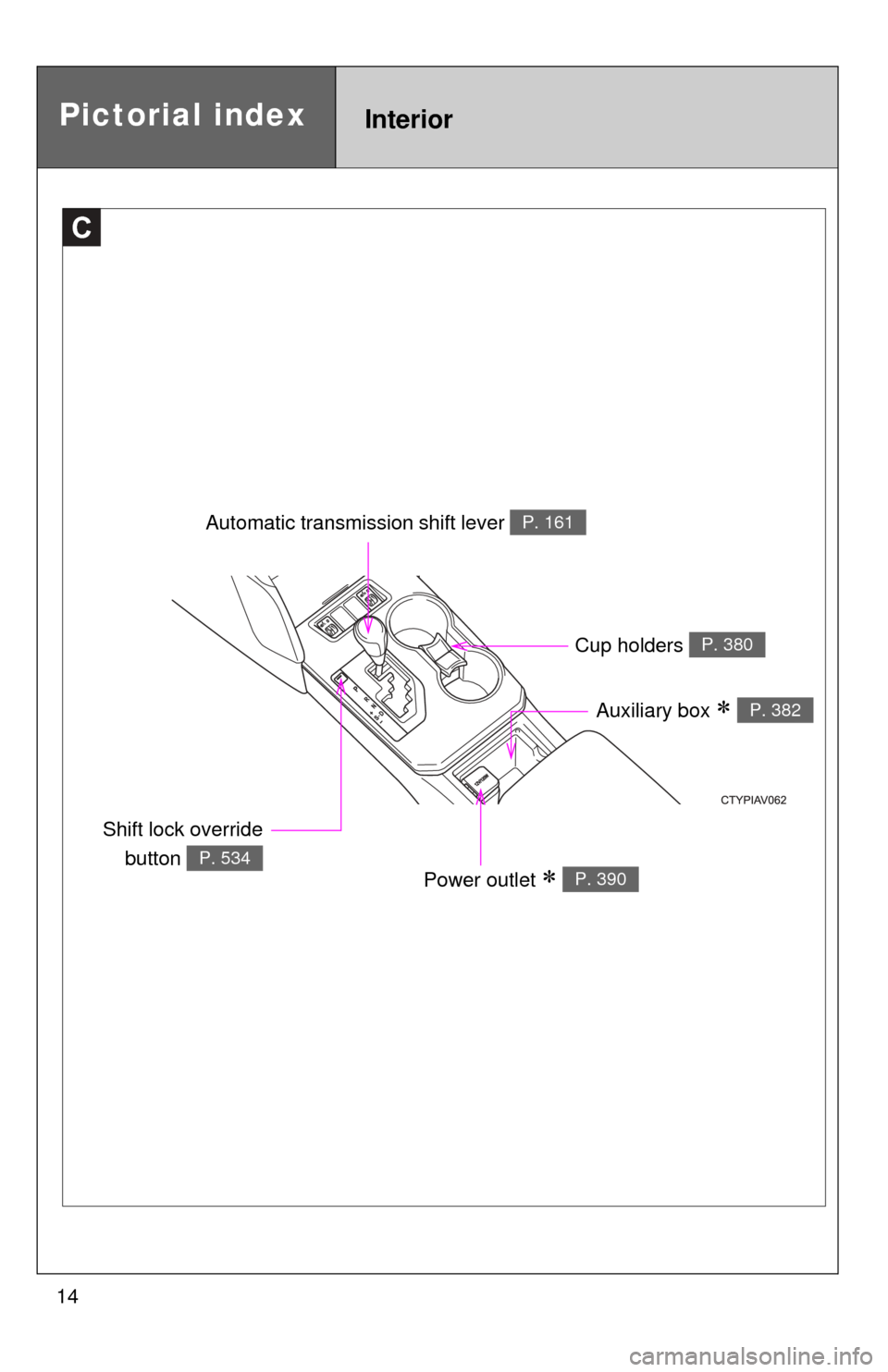
14
C
Automatic transmission shift lever P. 161
Cup holders P. 380
Pictorial indexInterior
Auxiliary box P. 382
Shift lock overridebutton
P. 534
Power outlet P. 390
Page 135 of 620
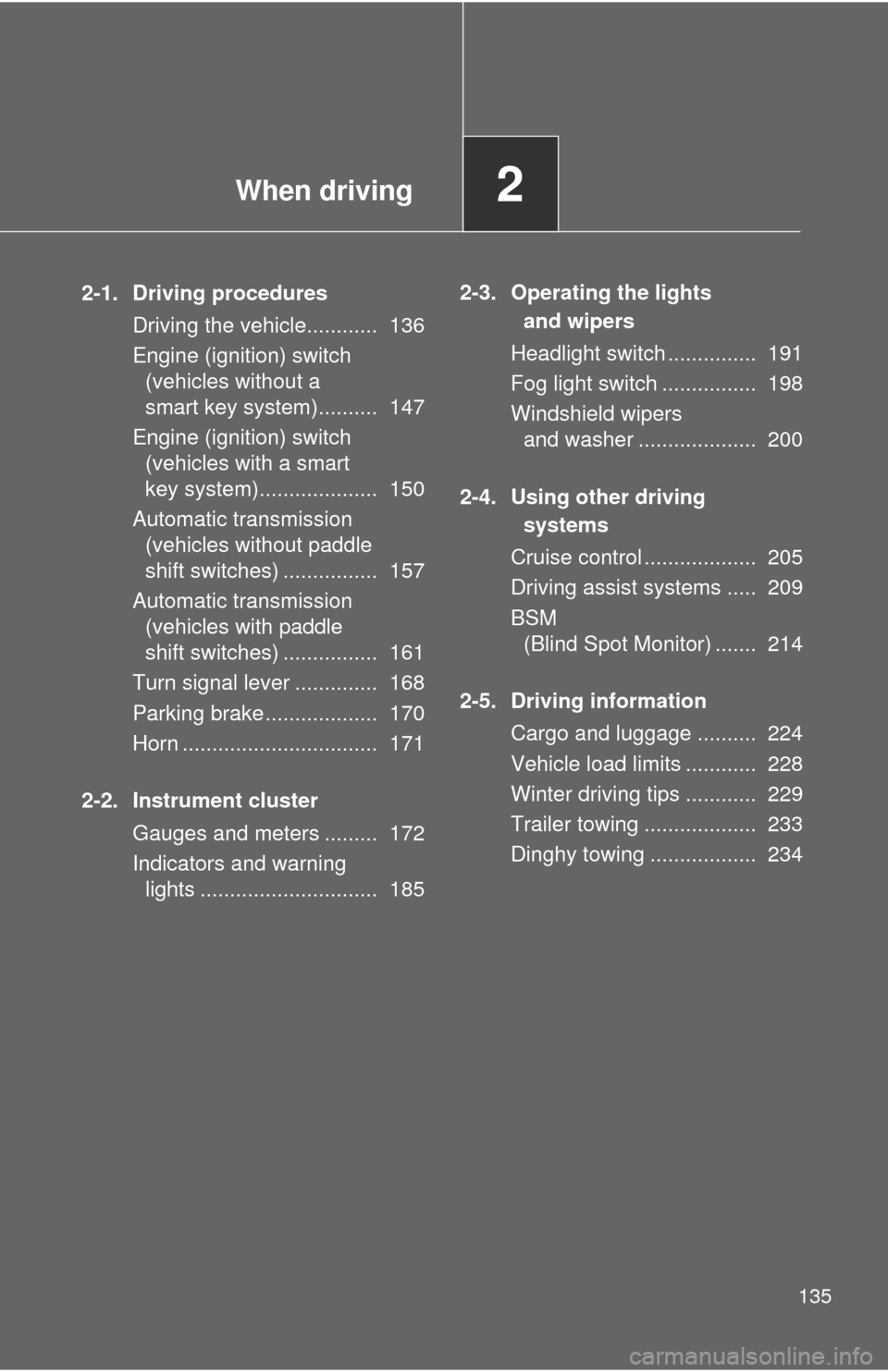
When driving2
135
2-1. Driving proceduresDriving the vehicle............ 136
Engine (ignition) switch (vehicles without a
smart key system).......... 147
Engine (ignition) switch (vehicles with a smart
key system).................... 150
Automatic transmission (vehicles without paddle
shift switches) ................ 157
Automatic transmission (vehicles with paddle
shift switches) ................ 161
Turn signal lever .............. 168
Parking brake ................... 170
Horn ................................. 171
2-2. Instrument cluster Gauges and meters ......... 172
Indicators and warning lights .............................. 185 2-3. Operating the lights
and wipers
Headlight switch ............... 191
Fog light switch ................ 198
Windshield wipers and washer .................... 200
2-4. Using other driving systems
Cruise control ................... 205
Driving assist systems ..... 209
BSM (Blind Spot Monitor) ....... 214
2-5. Driving information Cargo and luggage .......... 224
Vehicle load limits ............ 228
Winter driving tips ............ 229
Trailer towing ................... 233
Dinghy towing .................. 234
Page 139 of 620

139
2-1. Driving procedures
2
When driving
CAUTION
■
When starting the vehicle
Always keep your foot on the brake pedal while stopped with the engine run-
ning. This prevents the vehicle from creeping.
■ When driving the vehicle
●Do not drive if you are unfamiliar with the location of the brake and accel-
erator pedals to avoid depressing the wrong pedal.
• Accidentally depressing the accelerator pedal instead of the brake
pedal will result in sudden acceleration that may lead to an accident
that could result in death or serious injury.
• When backing up, you may twist your body around, leading to a diffi- culty in operating the pedals. Make sure to operate the pedals properly.
• Make sure to keep a correct driving posture even when moving the vehicle only slightly. This allows you to depress the brake and acceler-
ator pedals properly.
• Depress the brake pedal using your right foot. Depressing the brake pedal using your left foot may delay response in an emergency, result-
ing in an accident.
● Do not drive the vehicle over or st op the vehicle near flammable materials.
The exhaust system and exhaust gases can be extremely hot. These hot
parts may cause a fire if there is any flammable material nearby.
● Do not let the vehicle roll backward while the shift lever is in a driving posi-
tion, or roll forward while the shift lever is in R.
Doing so may cause the engine to stall or lead to poor brake and steering
performance, resulting in an accident or damage to the vehicle.
● If the smell of exhaust is noticed inside the vehicle, open the windows and
check that the trunk is closed. Large amounts of exhaust in the vehicle can
cause driver drowsiness and an accident, resulting in death or a serious
health hazard. Have the vehicle inspected by your Toyota dealer immedi-
ately.
● Do not shift the shift lever to P while the vehicle is moving.
Doing so can damage the transmission and may result in a loss of vehicle\
control.
Page 140 of 620

140 2-1. Driving procedures
CAUTION
●Do not shift the shift lever to R while the vehicle is moving forward.
Doing so can damage the transmission and may result in a loss of vehicle\
control.
● Do not shift the shift lever to D while the vehicle is moving backward.
Doing so can damage the transmission and may result in a loss of vehicle\
control.
● Moving the shift lever to N while the vehicle is moving will disengage the
engine from the transmission. Engine braking is not available when N is
selected.
● During normal driving, do not turn off the engine. Turning the engine off
while driving will not cause loss of steering or braking control, but the
power assist to these systems will be lost. This will make it more difficult to
steer and brake, so you should pull over and stop the vehicle as soon as it
is safe to do so.
In the event of an emergency, such as if it becomes impossible to stop the
vehicle in the normal way: P. 548
● Use engine braking (downshift) to maintain a safe speed when driving
down a steep hill.
Using the brakes continuously may cause the brakes to overheat and lose
effectiveness. ( P. 158, 162)
● Do not adjust the position of the steering wheel, the seat, or the inside or
outside rear view mirrors while driving.
Doing so may result in a loss of vehicle control that can cause accidents,
resulting in death or serious injury.
● Always check that all passengers' arms, heads or other parts of their body
are not outside the vehicle, as this may result in death or serious injury.
● Do not drive in excess of the speed limit. Even if the legal speed limit per-
mits it, do not drive over 85 mph (140 km/h) unless your vehicle has high-
speed capability tires. Driving over 85 mph (140 km/h) may result in tire
failure, loss of control and possible injury. Be sure to consult a tire dealer
to determine whether the tires on your vehicle are high-speed capability
tires or not before driving at such speeds.
Page 157 of 620
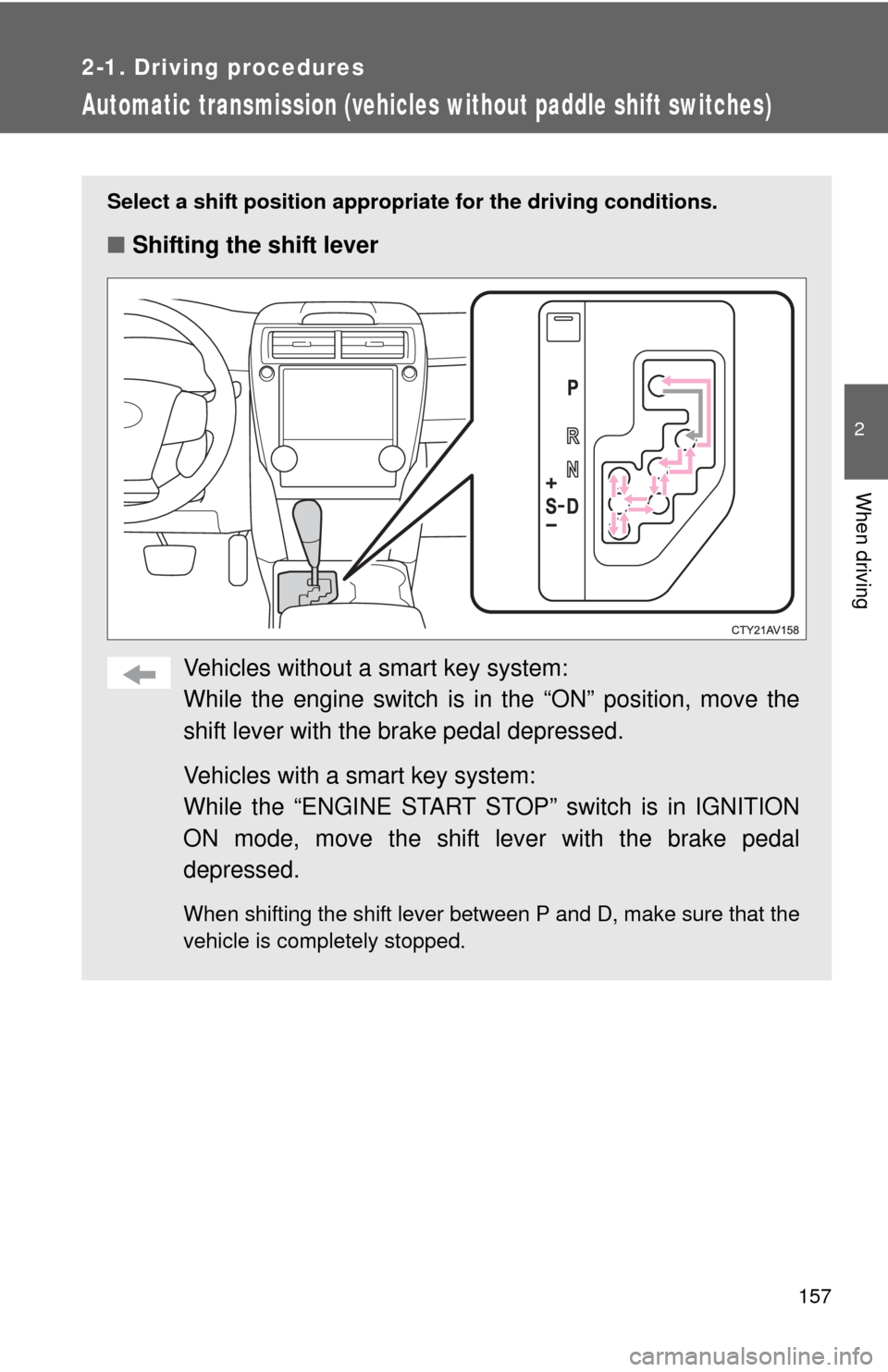
157
2-1. Driving procedures
2
When driving
Automatic transmission (vehicles without paddle shift switches)
Select a shift position appropriate for the driving conditions.
■Shifting the shift lever
Vehicles without a smart key system:
While the engine switch is in the “ON” position, move the
shift lever with the brake pedal depressed.
Vehicles with a smart key system:
While the “ENGINE START STOP” switch is in IGNITION
ON mode, move the shift lever with the brake pedal
depressed.
When shifting the shift lever between P and D, make sure that the
vehicle is completely stopped.
Page 159 of 620
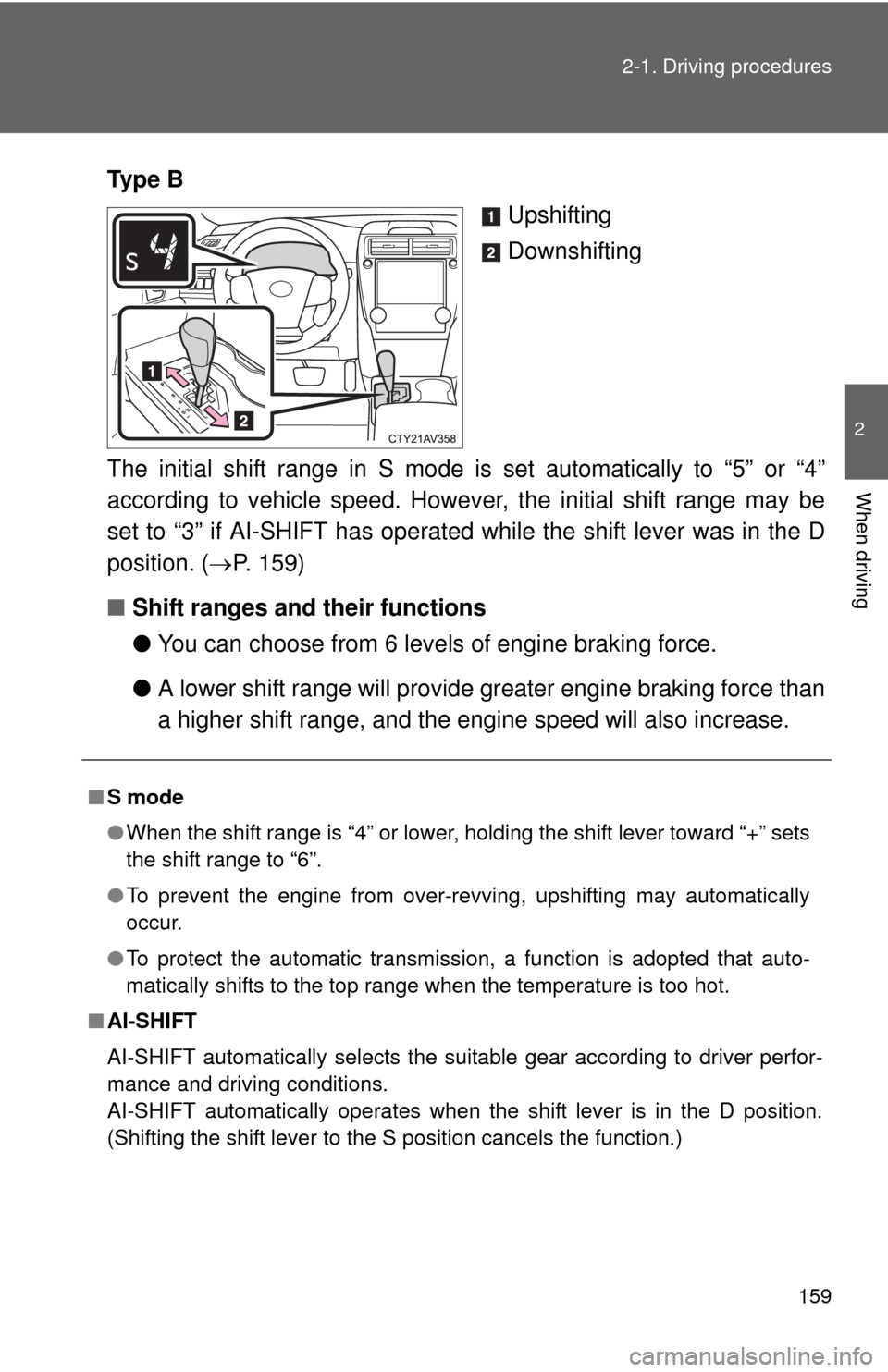
159
2-1. Driving procedures
2
When driving
Ty p e B
Upshifting
Downshifting
The initial shift range in S mode is set automatically to “5” or “4”
according to vehicle speed. However, the initial shift range may be
set to “3” if AI-SHIFT has operated while the shift lever was in the D
position. ( P. 159)
■ Shift ranges and their functions
●You can choose from 6 levels of engine braking force.
● A lower shift range will provide greater engine br aking force than
a higher shift range, and the engine speed will also increase.
■S mode
●When the shift range is “4” or lower, holding the shift lever toward “+” sets
the shift range to “6”.
● To prevent the engine from over-revving, upshifting may automatically
occur.
● To protect the automatic transmission, a function is adopted that auto-
matically shifts to the top range when the temperature is too hot.
■ AI-SHIFT
AI-SHIFT automatically selects the suitable gear according to driver perfor-
mance and driving conditions.
AI-SHIFT automatically operates when the shift lever is in the D position.
(Shifting the shift lever to the S position cancels the function.)
Page 160 of 620
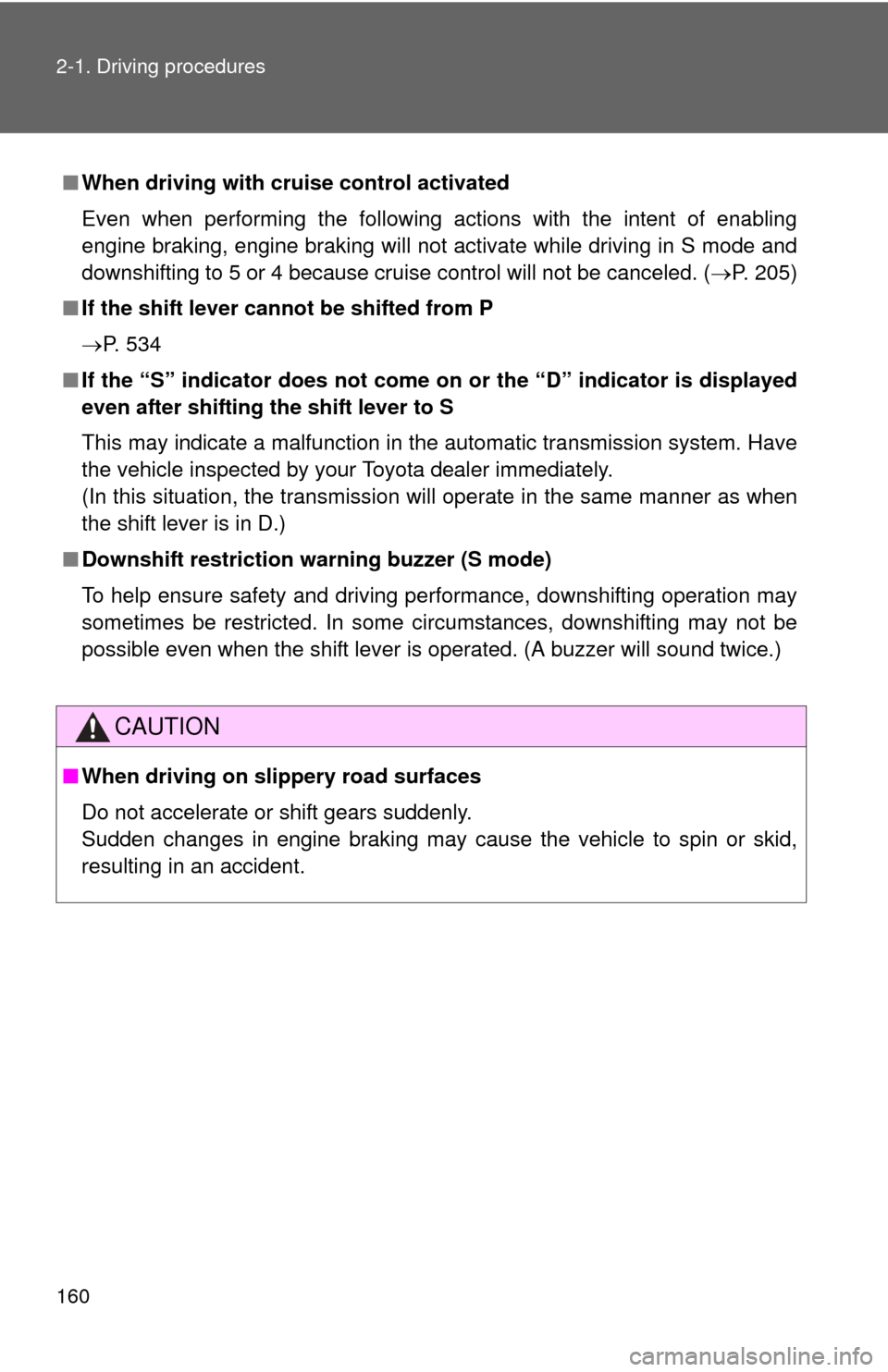
160 2-1. Driving procedures
■When driving with cruise control activated
Even when performing the following actions with the intent of enabling
engine braking, engine braking will not activate while driving in S mode and
downshifting to 5 or 4 because cruise control will not be canceled. ( P. 205)
■ If the shift lever cannot be shifted from P
P. 534
■ If the “S” indicator does not come on or the “D” indicator is displayed
even after shifting the shift lever to S
This may indicate a malfunction in the automatic transmission system. Have
the vehicle inspected by your Toyota dealer immediately.
(In this situation, the transmission will operate in the same manner as when
the shift lever is in D.)
■ Downshift restriction wa rning buzzer (S mode)
To help ensure safety and driving performance, downshifting operation may
sometimes be restricted. In some circumstances, downshifting may not be
possible even when the shift lever is operated. (A buzzer will sound twice.)
CAUTION
■ When driving on slippery road surfaces
Do not accelerate or shift gears suddenly.
Sudden changes in engine braking may cause the vehicle to spin or skid,
resulting in an accident.
Page 161 of 620
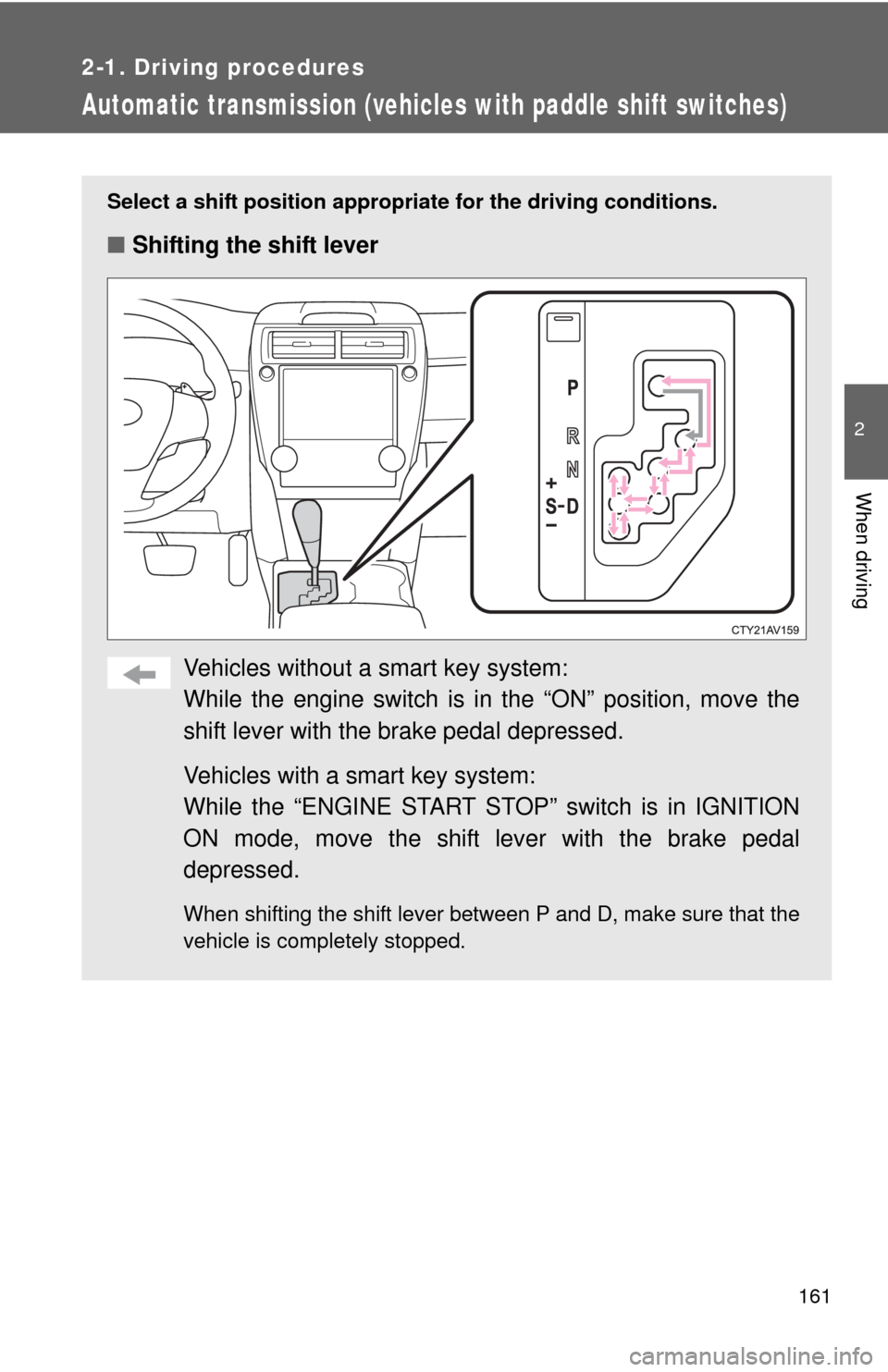
161
2-1. Driving procedures
2
When driving
Automatic transmission (vehicles with paddle shift switches)
Select a shift position appropriate for the driving conditions.
■Shifting the shift lever
Vehicles without a smart key system:
While the engine switch is in the “ON” position, move the
shift lever with the brake pedal depressed.
Vehicles with a smart key system:
While the “ENGINE START STOP” switch is in IGNITION
ON mode, move the shift lever with the brake pedal
depressed.
When shifting the shift lever between P and D, make sure that the
vehicle is completely stopped.
Page 166 of 620

166 2-1. Driving procedures
■S mode
●When the shift range is “4” or lower, holding the shift lever toward “+” sets
the shift range to “6”.
● To prevent the engine from over-revving, upshifting may automatically
occur.
● To protect the automatic transmission, a function is adopted that auto-
matically shifts to the top range when the temperature is too hot.
■ AI-SHIFT
AI-SHIFT automatically selects the suitable gear according to driver perfor-
mance and driving conditions.
AI-SHIFT automatically operates when the shift lever is in the D position.
(Shifting the shift lever to the S position cancels the function.)
■ When driving with cruise control activated
Even when performing the following actions with the intent of enabling
engine braking, engine braking will not activate while driving in D or S mode
and downshifting to 5 or 4 because cruise control will not be canceled.
(P. 205)
■ If the shift lever cannot be shifted from P
P. 534
■ If the “S” indicator does not come on or the “D” indicator is displayed
even after shifting the shift lever to S
This may indicate a malfunction in the automatic transmission system. Have
the vehicle inspected by your Toyota dealer immediately.
(In this situation, the transmission will operate in the same manner as when
the shift lever is in D.)
■ Downshift restriction warning buzzer
To help ensure safety and driving performance, downshifting operation may
sometimes be restricted. In some circumstances, downshifting may not be
possible even when the shift lever or paddle shift switches are operated. (A
buzzer will sound twice.)